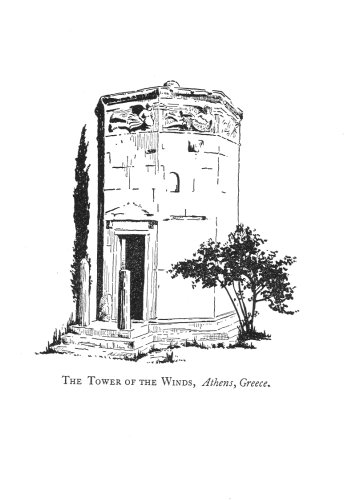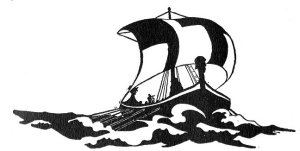Aeolus And The Tower Of The Winds |
A Greek Legend |

The winds of Greece are blowing, today, in sunny Athens, around the Tower of the Winds on Aeolus Street. The tower stands in an enclosed, grassy space, with a few trees and scattered stones -- as if left a little aside by the centuries. This tower had its origin in a daydream of Andronicus, lover of winds and stars; for, in spite of the belief of the early Greeks that all dreams live under the earth, Andronicus made his dream live actually on the earth, in plain sight of the Athenians.
It was in the first part of the century before Christ that Andronicus was chosen by the people of Athens to plan a tower which should contain a water clock -- this new tower to stand not far from the old market-place, on the low land lying north of the Acropolis. Now as Andronicus was something of an astronomer he decided to have sundials, also, on the water clock. So the tower was built, with a turret on the south side to contain the cistern which supplied the water for the water clock. The movement of water wheels caused the gradual rise of a small figure which pointed a rod to the hours on a dial.
The Athenians were much pleased with their new water clock, or clepsydra. Greeks of earlier centuries had had to look to the stars for their time at night. "What star is passing?" they would ask. The clepsydra was evidently better than that method; in fact, it was the most important part of the tower! But, to Andronicus, it was of small significance compared with the thought of his beloved winds; for his cherished daydream was that he would represent on the tower all the winds that blow across the land of Greece. Not only that! He would show to passersby in Athens the very wind that was blowing. The people should have their clepsydra, but the tower should have the winds!
Ever since his youthful days in Cyrrhus, Andronicus had cared for the winds and all the tales about them. He had an especially friendly feeling for Aeolus, king of the winds, whose cave, far away in a mountain on the island of Aeolia, north of Sicily, he knew as well as if he had seen it. Wasn't that cave the home of the winds who were really the sons of Aeolus? Weren't they kept imprisoned there to play merrily or roughly with one another until their royal master at times released one or more of them? Andronicus knew that winds varied as much as men: there were weak winds, strong winds, capricious winds, steadfast winds, winds that did nothing, winds that did everything. When Aeolus sent them forth, in the great bags that mortals call clouds, and bade them carry out his commands, what couldn't they accomplish of joy or sorrow?
Many a tale of Aeolus and the winds, Andronicus had known from boyhood. One of these tales was about Aeolus and Odysseus. In the course of his long voyaging, Odysseus and his comrades came to the island of Aeolia, one portion of which floated continually, yet never floated away. Surrounding the steep shore, was a high wall of bronze through which no man could easily break. Behind this protecting wall, Aeolus and his large family dwelt happily, singing and feasting. When the ship of Odysseus neared Aeolia, the gods favored him, for he and his men, by heroic effort, were able to climb the wall of bronze and to enter the island. The heart of King Aeolus instantly warmed at sight of Odysseus, for he gave him welcome to his royal dwelling and bade him and his comrades tarry as long as they would. Joyous feasts now went on, day after day, and, during the feasts, Odysseus, in return for the lavish hospitality of Aeolus, told many a story -- stories of Ilium, of the Argive ships, and of the Achaeans. Aeolus and his family listened spellbound. After a month of idleness and feasting, Odysseus became restless for new adventures and told King Aeolus that he was eager to see Ithaca, his home, once more. Aeolus did not try to keep him longer as his guest, and even made him a parting gift. This gift was a huge sack of ox-skin in which all the winds, except the west wind, were tightly bound. When Odysseus boarded his ship, Aeolus himself tied the sack to the mast with a shining silver cord and told the west wind to waft the ship along. Then he bade Odysseus farewell.
Nine days and nine nights, Odysseus and his men sailed on. At dawn, on the tenth day, their hearts were glad because the fields of Ithaca came into view, and, on the shore, men could be seen tending the beacon fires. Odysseus, thankful to be nearing the end of his voyage and utterly worn out by his constant watching, now allowed one of his men to guide the ship, though, during the nine days and nights, he himself had continually held the sheet and carefully watched the course. Sleep immediately overpowered him.
While he slept, his men began to talk among themselves about the sack. One said, "I am sure Odysseus is bringing home gold and silver as gifts from generous Aeolus." Another spoke up angrily, saying, "Why is it all men give high praise to Odysseus, no matter where he goes? Remember you not, when we came from Ilium, he was laden with treasures, but we had nothing? Assuredly King Aeolus has given to him great gifts, but what, now, have we?" And still another bold sailor said, "Come, let us see what is in the sack!" Quickly -- for fear Odysseus should wake -- they cut down the ox-hide bag.

Instantly, all the winds rushed forth, knocking aside the gentle, west wind, stirring up stormy waves and knocking overboard several sailors. Odysseus, roused by the commotion, awoke in dismay and was inclined at first to throw himself overboard, but then decided to endure his fate, even though he could no longer guide the ship. Covering his head he laid himself down beside his lamenting companions, while the fierce winds drove the ship back to Aeolia. When driven ashore there, Odysseus, taking with him one of his comrades and a herald, climbed again over the wall of bronze and sought the dwelling of Aeolus. Humbly the three sat down on the threshold by the doorposts. Aeolus, his wife and their sons and daughters, looked wonderingly at the suppliants, for some time, before a word was spoken.
"How came you here, Odysseus?" Aeolus then asked. "We sent you forth with all care and help."
"Betrayed was I by my crew," answered Odysseus, "and by treacherous sleep. I pray you help me, for you can." Silence fell upon the hall until Aeolus spoke again. "Out of my island at once!" he shouted. "Know that I will not help twice a man whom the gods have spurned! Begone!"
So Odysseus, lamenting, turned away and sailed on through rough seas, but in his heart he believed the gods were still friendly to him.
Other stories of Aeolus Andronicus could tell, but he preferred the varying winds themselves to the stories of them. Wind lover that he was, he decided, then -- when asked to build a tower -- to have all the winds seen flying around this tower. For, he said, if all the winds in the world could dwell in one cave, surely the eight chief winds might have a resting-place on a tower, and he would have these eight winds carved in bold relief. He wished -- wished, indeed, with all his heart -- that Phidias were still alive, to glorify the tower at the foot of the Acropolis as he had glorified the Parthenon on the top. However, Andronicus knew Athenian sculptors who could carve figures of the winds which would be recognizable, at least, and he knew that he himself was able to take a hand in the carving. So the tower was built -- a marble tower, eight-sided and on each side, in bas-relief, a flying figure of a wind.
Look, now, at these winds. From the street north of the tower -- a street of gay shops to-day -- one sees "sky-born" Boreas with his buskins and his thick chiton. As he flies he blows through a shell. Andronicus knew, as did all Greeks, that this Boreas was a powerful fellow, who could come down from hilltops in gigantic strides, uprooting oak trees in his path, or overturning ships. For Boreas was the leader of the strong winds, with wings on his feet as well as on his shoulders, and Homer once said of him, that he, "drove thistle-heads in autumn along the plain."
On the next side of the tower is Kaikias, the northeast wind -- an old man, but almost as vigorous as Boreas -- carrying in his hand a shield out of which he shakes hailstones, or perhaps ripe olives.
Then comes flying lightly along young Apeliotes, the rainy, east wind, bringing grain and fruit. In the days when the tower was built, Apeliotes looked directly at purple Mount Hymettus that seems to embrace in its wide sweep all Athens. Houses, today, shut out his view of the mountain.

Next to youthful Apeliotes, comes Eurus, the southeast wind -- a scowling, bearded man, clad in a long garment, the folds of which he holds rather threateningly before his face. Eurus brings storms. His warm breath melts snow, but makes rain fall. From his wings, declared the Greeks, a heavy mist falls upon the slopes of the hills and a blinding fog creeps over the sea. No wonder sailors despaired when Eurus blew!
Facing the Acropolis is Notus, the showery south wind -- a youth lightly clothed and barefooted, who holds an inverted jar from which rain may pour. Notus was sometimes a favoring wind, but often, an adverse one. Andronicus could have told you of the time when Notus, in company with Eurus, Zephyrus, and Boreas, "forth rushed together" to overwhelm Odysseus, at Poseidon's command to the waves to raise a storm. Another time, Odysseus safely passed the rocks of Scylla and Charybdis and moored his ship for many days in a safe harbor, and "all that month incessant south winds blew."
Barefooted Lips flies next to Notus. He carries the aplustre, the stern ornament of a ship, to show that he wafts the ships home in safety. All Greek sailors love Lips, the southwest wind.
On the west side of the tower, which faces the old market-place with its stately entrance-gate, floats airily along; Zephyrus, the west wind. He is a young man and, as he flies, he scatters flowers from the folds of his garment. Zephyrus, both gentle and "hard-blowing," once aided the voyage of Telemachus, son of Odysseus, when the goddess Athene sent "a brisk, west wind that sang along the wine-dark sea"; but after Odysseus, in his journeyings, had left the Island of the Sun "a shrill west wind arose blowing a heavy gale."
Between Zephyrus and Boreas, the northwest wind is flying, Skiron, who dries up the earth with a scorching blast. He is an old man, carrying a brazier of hot charcoal.
These, then, are the winds of Aeolus, summoned by Andronicus to dwell on the tower. Day and night, the winged figures fly around the tower. To show which wind, at any moment, was strongest, Andronicus surmounted the top with a bronze Triton, turned by the breeze, his rod pointing downward at the figure of the particular wind then blowing. The Triton perished long ago, as did also the two porticoes of the tower. But, under each figure of a wind, are still the lines of a sundial, with a projecting bar of metal, from which Athenians, even today, can tell the hour, if they wish.
Three divinities guarded the tower: Apollo, the sun-god, without whose power mortals could not have known the true sun time; Poseidon, god of the sea, in whose charge was the water that supplied the clepsydra; and Aeolus, who held the mastery of the winds. Moreover, Athene, eternal wisdom, is perpetual guardian, for an inscription on a piece of architrave dedicates to her the whole tower.

For twenty centuries, the winds of Greece have swept around this small, plain tower -- tempestuous, uncertain winds of winter, or gentle, persistent winds of summer. For twenty centuries, the sun has told the time upon the dials of the tower. Andronicus did not think it necessary to build a tower as high as Olympus to win the protection of the gods, nor one as high as the clouds to secure the presence of the winds. For he was sure that the mighty winds who once dwelt in a cavern would be content, also, in keeping close to even a low tower of their own. Ages before the tower was built, Aeolus had bidden his winds leave their cave in Aeolia and fare forth through the world. So Boreas, Zephyrus, and the rest, departing from Aeolia, had blown across Italy, and across Greece to the Delphi Mountains, and beyond. The same winds are blowing, today, in Athens, around the Tower of the Winds, on Aeolus Street.
Sources And Further Reading |
Sacred Texts Tower Legends by Bertha Palmer Lane[1932]